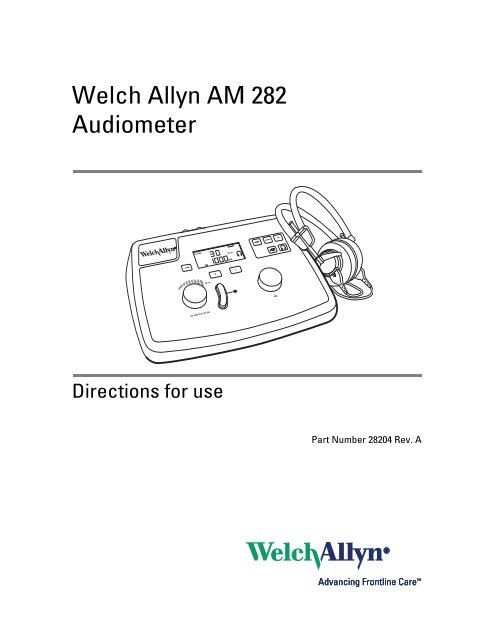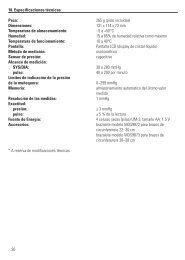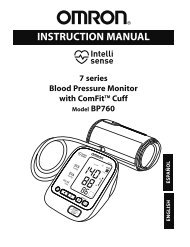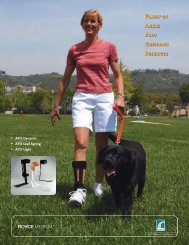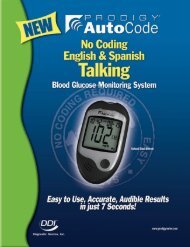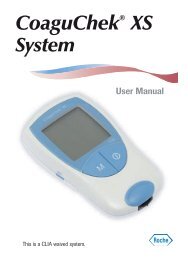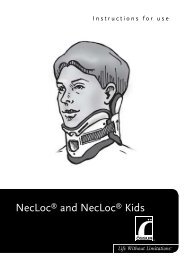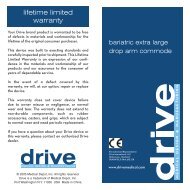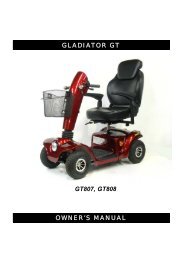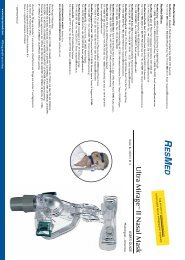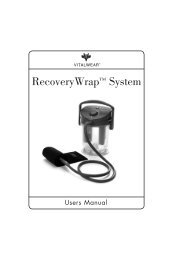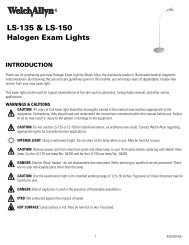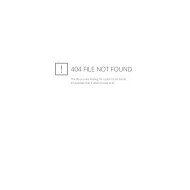User Manual - Medical Supplies
User Manual - Medical Supplies
User Manual - Medical Supplies
You also want an ePaper? Increase the reach of your titles
YUMPU automatically turns print PDFs into web optimized ePapers that Google loves.
ivWelch Allyn AM 282 Audiometer
11IntroductionThe AM282 Audiometer is a single-channel, pure tone, air conduction, portable instrumentdesigned to provide basic audiometric screening capability for physicians' offices andindustry. The lightweight design allows easy transport to a variety of testing locations. Theclearly labeled front panel controls and full frequency range make accurate, reliabletesting a simple matter for any user.The AM282 Audiometer is a precisely designed and calibrated instrument. With propercare it will deliver accurate sound-pressure levels to subjects' ears for hearing screeningprogramsNoteThe AM282 Audiometer should be calibrated yearly (or sooner if a problemdevelops) by a Welch Allyn certified technician. See Chapter 3.Unpacking and inspectionAlthough this AM282 Audiometer was carefully tested, inspected and packed forshipping, it is good practice after receiving the instrument to immediately examine theexterior of the container for any signs of damage. Notify the carrier if any damage isnoted.Carefully remove the AM282 Audiometer from its shipping container. If the instrumentappears to have suffered mechanical damage, notify the carrier immediately so that aproper claim can be made. Be certain to save all packing materials so that the claimadjuster can inspect it as well. As soon as the carrier has completed the inspection, notifya Welch Allyn representative.If the instrument must be returned, repack it carefully (in the original AM282 Audiometercontainer if possible) and return it prepaid to Welch Allyn for necessary adjustments.Supplied AccessoriesCheck that all accessories itemized in Accessories supplied below are received in goodcondition. If any accessories are missing, contact Welch Allyn immediately. See“Accessories” on page 25 for the catalog numbers of accessories and also for a listing ofoptional accessories.Welch Allyn Part NumberWelch Allyn Description28209 Audiometry Headset External28208 AM282 Audiogram Forms (1 pad of 50)28204 AM282 Directions for Use <strong>Manual</strong>28202 AM282 Carry Case
2 Introduction Welch Allyn AM282 Audiometer28207 AM 282 Power Plug28201 AM282 Power Supply28206 Threshold Audiometry CardOptional Accessories23220 Audiometry Patient Response Switch23221 Audiometry Single Patch Cord, 2-Conductor23222 Audiometry Audiocups28203 Audiometry Ear Tone Insert PhonesRecycling / disposalSafety SummaryWARNING To ensure patient safety and optimal product performance, use onlyWelch Allyn recommended accessories and suppliesCaution Many local laws and regulations require special procedures to recycleor dispose of electric equipment-related waste including batteries, printed circuitboards, electronic components, wiring and other elements of electronic devices.Follow all of your respective local laws and regulations for the proper disposal ofbatteries and any other parts of your system.Before using the AM282 Audiometer, familiarize yourself with the sections of thisdirections for use that pertain to your use of the AM282 Audiometer.• Failure to understand and observe any warning statement in this manual could lead topatient injury, illness, or death.• Failure to understand and observe any caution statement in this manual could lead todamage to the device or other property, or loss of patient data.WARNING Warnings indicate conditions or practices that could lead to illness,injury, or death.Caution Cautions indicate conditions or practices that could damage theequipment or other property.NoteNotes help you identify areas of possible confusion and avoid potential problemsduring system operation
Directions for Use Introduction 3Safety NotesWARNING The AM282 is designed for compliance to IEC and UL 60601-1 whenused in the patient vicinity. To achieve this compliance, use of hospital grade plugand receptacles are required. For patient and operator safety, the AM282 must beused with properly grounded plug and receptacles at all times. The AM282 isequipped with a specific power transformer (UE100503HKKK3-P, reorder number28201), which should not be interchanged with any other transformer or supply.WARNING Any program aimed at obtaining reliable records of hearingthresholds should be staffed and supervised by appropriately-trained individuals.Latex is not used any where in the manufacturing process.The base material for the earphone cushions is made from natural and synthetic rubber.WARNING This symbol indicates the location of a service adjustment partand is intended for service personnel only. The AM 282 is a specifically calibratedaudiometer and the periodic service and adjustments for the instrument that maybe required should be done only by an authorized service technicianWARNING Please read the entire manual prior to using the AM282 to becomefamiliar with the test functions and proper accessory connections.WARNING Accessory equipment connected to the analog and digital interfacesmust be certified to the respective IEC standards (IEC950 for data processing orIEC 60601-1 for medical equipment). Furthermore, all configurations shall complywith the system standard IEC 60601-1-1. Everyone who connects additionalequipment to the signal input or signal output port configures a medical system,and is therefore responsible that the system complies with the requirements ofthe system standard IEC60601-1-1. If in doubt, consult the technical servicedepartment or a local Welch Allyn representative.Customer ResponsibilityWARNING This product and its components will perform reliably only whenoperated and maintained in accordance with the instructions contained in thismanual, accompanying labels, and/or inserts. A defective product should not beused. Make sure all connections to external accessories are snug and securedproperly. Parts which may be broken or missing or are plainly worn, distorted orcontaminated should be replaced immediately with clean, genuine replacementparts manufactured by or available from Welch Allyn.WARNING This product should not be used in the presence of fluid that cancome into contact with any of the electronic components or wiring. Should theuser suspect fluids have contacted the system components or accessories, theunit should not be used until deemed safe by a Welch Allyn certified servicetechnician.
4 Introduction Welch Allyn AM282 AudiometerWarrantyWARNING Do NOT use in the presence of flammable gaseous mixtures. <strong>User</strong>sshould consider the possibility of explosions or fire when using this device inclose proximity to flammable anesthetic gases.WARNING Periodically, have a service technician perform electrical safetychecks on the unit in order to show continued compliance to IEC and UL 60601-1.We, Welch Allyn, warrant that this product is free from defects in material andworkmanship, and when properly installed and used, will perform in accordance withapplicable specifications. If within one year after original shipment it is found not to meetthis standard, it will be repaired, or at our option, replaced at no charge except fortransportation costs, when returned to an authorized product service facility.NoteChanges in the product not approved in writing by Welch Allyn shall void thiswarranty. Welch Allyn shall not be liable for any indirect, special or consequentialdamages, even if notice has been given in advance of the possibility of suchdamages.THIS WARRANTY IS IN LIEU OF ALL OTHER WARRANTIES, EXPRESS OR IMPLIED,INCLUDING BUT NOT LIMITED TO, ANY IMPLIED WARRANTY OF MERCHANTABILITYOF FITNESS FOR A PARTICULAR PURPOSE.
Directions for Use Introduction 5Installation1. Plug the power cord into the appropriate jack (R5) on the rear panel.2. Plug the power cord from the Power Module into a line power (mains) outlet.3. Plug the earphones into the earphone jacks on the rear panel. R3 is for the right andR4 is for the left earphone/insert phone.4. Turn the power switch to ON (R6).Rear panel connectorsR1R2R3R4R5R6Covered by a sticker and intended for service personnel only.Patient Hand Switch input jack (standard phone jack).Right ear phone output jacks (standard phone plug). Insert either the External Headsetor Internal Earphone jacks.Left earphone output jacks (standard phone jack). Insert either external headset orInternal Earphone plugs.Power Input jack (2.1 mm pin).Power switch.Symbols on the AM282 AudiometerSymbolDescriptionAttention, consult accompanying documents.Date of manufactureCE Marked in accordance with the European Council Directive 93/42/EEC concerningmedical devices.<strong>Medical</strong> device listing mark for U.S. and Canada by Intertek Testing Service.Special Recycling Required. Do not dispose in landfill.Type B equipment.
6 Introduction Welch Allyn AM282 AudiometerSymbolDescriptionSymbol for “CATALOG NUMBER.”Stand-by.Right Ear.Left Ear.Patient Response Button.AC PowerWARNING Do not turn on/off system power while a patient is wearing theheadsets or internal earphones.WARNING Use only the provided power supply. The AM282 Audiometerprovided power supply should only be connected to a power source meeting thefollowing range: 90-246VAC, 47-63Hz. In North America, the power source shouldbe a maximum of 120VAC.Bottom panelB1B2B1B2Serial number of systemBattery compartmentSee “Replacing the batteries” on page 10 for detailedinstructions.
Directions for Use Introduction 7Controls and indicatorsF1F2Range extension pushbutton allows you to increase the stimulus intensity 10 dB above thestandard maximum HL at any frequency. When in use, a “+” appears on the LCD.Liquid Crystal Display (LCD).F3 Selects steady stimulus tone type. The symbol is shown in the upper right handcorner of the display when selected.F4 Selects pulsed stimulus tone type. The symbol is shown in the upper right hand cornerof the display when selected.F5Selects frequency modulated stimulus tone type. FM is shown in the upper right hand cornerof the display when selected.F6 Selects the calibration file for external headset transducers. When the button is pressed,the display will flash. Press the button again to engage the external headset transducer.The symbol is shown on the right side of the display when selected.F7 Selects internal earphone calibration file for transducers. When the button is pressed,the display will flash. Press the button again to engage the internal earphonetransducers. The symbol is shown on the right side of the display when selected.F8F9Control for setting the stimulus frequency. Frequency is indicated in the bottom center of thedisplay.Select to present the stimulus to the Left ear. An “L” will appear in the lower right side of thedisplay to indicate the stimulus is being routed to the left ear.F10 Present bar for stimulus presentation. The symbol appears on the left side of thedisplay when the stimulus is being presented.F11F12Select to present the stimulus to the Right ear. An “R” will appear in the lower left side of thedisplay to indicate the stimulus is being routed to the right ear.Hearing Level knob for setting the stimulus intensity level. Level is indicated on the center topof the display.Note The symbol is located on the rear panel of the AM282 Audiometer anddenotes a Type B applied part.
8 Introduction Welch Allyn AM282 AudiometerLCD displayLegend Icons/LEDs Description1 AC PWR Indicates power is on.2 SW VERSION Indicates the current software version.3 When displayed, the stimulus is being presented.4 When displayed, an additional 10dB is available at the test frequency.5 When displayed, indicates the Patient Response button is being pressed.6 R Stimulus is being presented to the right ear.7 Stimulus frequency indicator.8 L Stimulus is being presented to the left ear.9 Indicates the battery is low.10 The headset calibration file is applied to the stimulus and Headphones should beused. Press this button twice to activate the calibration file.11 The insert phone calibration file is applied to the stimulus and Insert phones shouldbe used as the transducer. Press this button twice to activate the calibration file.12 FM The stimulus is a Frequency Modulated (FM) tone.13 The stimulus is a continuous tone.14 The stimulus is a pulsed tone.15 Stimulus presentation level.orNot enough power from the batteries to operate the system.
Directions for Use Introduction 9AC powerAn AC power supply can be purchased to use with the AM282 Audiometer.Connecting the AC power1. Ensure the system is turned off while connecting the AC Power.2. Plug the AC power supply into the power supply receptacle located next to the powerswitch on the rear panel.3. Connect the power cord to the Power Supply brick.4. Plug the Power cord into the wall socket.5. Turn the power ON.When the power supply is plugged into the unit, the power from the batteries will beswitched off automatically to preserve battery life.Disconnecting the AC powerBattery operationSleep modeWARNING Use only the Welch Allyn provided power supply. The AM282Audiometer provided power supply should only be connected to a power sourcemeeting the following range: 90-246VAC 47-63Hz. In North America, the powersource should be a maximum 120VAC.1. Turn the system OFF.2. Disconnect the power supply from the wall outlet.3. Remove the power supply from the rear panel.The AM282 Audiometer requires 5 x 1.5V AA alkaline batteries. It can also use 5 x 1.2V AANiMH or NiCad batteries if rechargeable batteries are desired. The AM282 Audiometerdoes not have a built-in charger, rechargeable batteries should be purchased with therecommended charger for those batteries. Welch Allyn recommends the purchase ofextra rechargeable batteries to ensure a fully charged supple of batteries will be available.The system was designed to operate for 10 hours on rechargeable batteries. Alkalinebatteries may last longer than 10 hours.Caution Remove the batteries from the AM282 Audiometer if it is not going tobe used for an extended time.When using battery power, the AM282 Audiometer will enter a power saving mode (thisis called sleep mode and is indicated by dashes on the LCD display) if the buttons on theFront Panel have not been pressed for 5 minutes. To exit the sleep mode, press thePresentation button.
10 Introduction Welch Allyn AM282 AudiometerLow battery indicatorWhen there is approximately 1 hour of battery time left, theon the screen.icon will be displayedWhen the battery can no longer provide enough power to operate the AM282Audiometer, the word OFF will be displayed on the LCD and the system will no longerfunction. At that point, replace the batteries (with new or fully charged batteries) or usethe AC Power Module to continue testing.Replacing the batteriesRemoving the batteriesWARNING Do not touch the patient and the battery terminals at the same time.The battery cover is to be closed at all times except when replacing the batteries.Batteries are to be replaced only by qualified personnel. Always turn off thesystem before replacing the batteries.Always inspect batteries for leakage and do not use if the batteries show anysigns of damage. The batteries should be the same type. When replacingbatteries, replace all of the batteries at the same time for optimal battery life.The AM282 Audiometer requires 5 x 1.5V AA alkaline batteries. It can also use 5 x1.2V AA NiMH or NiCad batteries if rechargeable batteries are desired.The battery compartment on the AM282 Audiometer is located on the bottom of the baseunit.To open the battery compartment,1. Gently squeeze the tab toward the door and away from the concave half circle and liftthe door upward.2. Reach into the compartment through the empty battery slot and gently force thebattery up until it is free from the silver battery contacts.3. Repeat for all 5 batteries. Do not simultaneously touch both sides of the batterycontacts at any time.
Directions for Use Introduction 11Inserting new batteriesBefore inserting new batteries in the battery compartment, always inspect batteries forleakage and do not use batteries that show any signs of damage.1. Insert the batteries starting with the battery slot farthest from the slot that is notused. Be sure to match the + side of the battery with the marked + side for eachbattery slot.2. Place the + side of the battery in at an angle and then push down on the – side of thebattery until the battery fits securely.3. Replace the battery compartment cover by inserting the square pegs into the slotsand gently pushing down until the tab snaps into place and the compartment door isflush with the bottom of the AM282 Audiometer.
12 Introduction Welch Allyn AM282 Audiometer
132OperationPreliminary checkThroughout this chapter are references to front panel (F) and rear panel (R) connectors,controls and indicators. Please refer to“Rear panel connectors” on page 5, “Controls andindicators” on page 7 and “LCD display” on page 8 of this manual for specificdescriptions and locations.1. Prior to testing, ensure that the power cord or the batteries are in place and earphonecords are plugged in securely.2. Turn the audiometer on.3. Select the desired tone type (steady, pulsed or FM).4. Make whatever notations your procedure requires on the audiogram form.Caution Always handle earphones with care. Neither drop them nor permitthem to be squeezed together. Severe mechanical shock may change theiroperating characteristics and require their replacement.NoteAlways clean and maintain earphone cushions for hygiene purposes. Checkperiodically for cracking or signs of wear. Cleanse cushions daily or after each use(depending upon population being tested). Use a solution of diluted alcohol ormild soap and water. Do not allow any of the cleaning solution to enter into theearphone speaker. Use earphones only when completely dry. Insert the earphonecords between the earphone cushions during storage to prevent damage frommechanical shock.Pretest noise recovery periodNoteThe generic term “subject” used in this manual is used to identify the personwhose hearing is being evaluated.Two prerequisites are of particular importance to the procurement of reliable audiograms:• Prior to testing, allow enough time for the subject to recover from the effects of noiseexposure. Exposure to high levels of sound (unmuffled lawn mowers, power tools,loud music, gunfire, etc.) tends to create a temporary threshold shift (TTS), whichdiminishes with time after exposure. If a subject is tested too soon after noiseexposure, a hearing test may indicate a hearing loss that does not reflect the subjectstrue hearing. It is recommended that the testing procedure prescribe some timeinterval - usually at least 16 hours – between the last exposure to high-level sound andthe administration of any hearing test.
14 Operation Welch Allyn AM 282 AudiometerTest environment• Tests should be performed in a quiet area.WARNING Any program aimed at obtaining reliable records of hearingthresholds should be staffed and supervised by appropriately-trained individuals.Training courses leading to certification are available for audiometric technicians inmost urban areas.Excessive noise in the test environment can reduce test validity by masking test tones.The test site should be away from conversation, printers, hallway traffic, outside autotraffic, and other noise producing environments. An acoustically tested room may berequired if room noise at the subject’s ears reaches objectionable levels. Audiocups areavailable from Welch Allyn as an optional accessory for use with the external headsetheadphones. Insert earphones are another option in noisy test environments. Theyprovide greater than 30 dB reduction of external noises. If the test subject is in the sameroom as the audiometer, it is recommended that the subject be seated about 1 meter(approximately 3 feet) away from the instrument.Maximum permissible test environment sound-pressure levels are specified by AmericanNational Standard Criteria for Permissible Background Noise during Audiometric Testing,S3.1-1977 (revised). The table below shows the maximum background levels that can bepresent inside the room while a valid hearing test is being conducted. For morecomprehensive information about hearing testing and hearing conservation, refer to theBibliography.Test Tone Frequency (Hz) 125 250 500 750 1000 1500 2000 3000 4000 6000 8000*Test Room- Maximum dB SPL 34.5 23.0 21.5 22.5 29.5 29.0 34.5 39.0 42.0 41.0 45.0*Ears covered with earphone mounted in MX-41/AR cushion.Providing patient instructionsPut the subject as much at ease as possible before the test begins. In addition, help thesubject understand how the test is to be conducted and what the subject will hear.Uniform and unvarying instructions should be given to each subject in order to achieveconsistent and reliable test results. The following is an example of standard instructions:“I am going to place these earphones over your ears. You will hear tones orbeeping sounds which may be loud or soft. Whenever you hear, or think you hearone of these tones, raise your hand. Lower your hand when you no longer hearthe sound. Remember, raise your hand when you hear the tone and lower yourhand when you do not.”Modify the instructions accordingly if the optional response handswitch is to be used.Placing the earphonesProper placement of the earphones on the ears is essential to achieve reliable test results.
Directions for Use Operation 15Response handswitcha. Eliminate all obstruction between earphone and subject (hair, eyeglasses,earrings, hearing aids, etc.).b. Adjust the headband so the earphone cushions are centered over the ears andhead. The earphone cushions will put firm pressure on both ears.If the optional response handswitch is used ensure that the plugs and jacks are properlyconnected.Welch Allyn Audiogram FormThe Welch Allyn Audiogram Form consists of three distinct parts:• Space for entering personal information about the subject to be tested.• A convenient chart for manually plotting test data.• Space for entering comments about the subject or the test.AUDIOGRAMNameNo.Audiometer Model No.Serial No.Age Gender Date Time-100102030Job LocationExaminerSignatureSymbolsEar - PhoneLeft - BlueRight - RedResponseNoResponseTDH earphoneInsert phoneHearing Level (dB)ISO 389 (1985) ANSI S3.6 (2004)IEC 60645-1 (2001)4050607080Comments90100110120125 250 500 750 1000 1500 2000 3000 4000 6000 8000Part No : 28208 Rev AFrequency (Hz)Welch Allyn, Inc4341 State Street Road, Skaneateles Falls, NY 13153-0220 USATel: 800 535 6663 Web: www.welchallyn.comRoutine test administrationTransducer selectionThe AM 282 Audiometer provides options for either headset or insert transducers.Selectingthethe will apply the calibration values for the headset. Selectingwill apply the calibration values for the insert earphones. To make the selectionfor the headset, press thebutton and the headset icon will flash on the LCD.
16 Operation Welch Allyn AM 282 AudiometerTo confirm the selection push thebutton again. To make the selection for insertearphones, press thebutton and the insert earphone icon will flash on the LCD. Toconfirm the selection push thebutton again.See “Appendix A” on page A for applied reference threshold values (RETSPL) for both theexternal headset and the internal earphones.HL knobThe HL knob increases or decreases the signal intensity in 5 dB increments. Rotating theControl knob clockwise increases the intensity; counterclockwise decreases intensity.When the maximum or minimum available intensity is reached for any frequency, thedisplay will flash.Range Extension pushbuttonTone Type selectorTypical testing sessionThis control allows the operator to present tones of up to 10 dB above the standardmaximum HL at any frequency. It will only function when the intensity is set within 10 dBbelow the maximum standard intensity at any frequency. This feature requires an extrastep to access the highest available intensities. It prevents accidental presentation of thehighest intensities to normal subjects.To enable the range extension feature, press the button labeled +10 dB while the intensityis at the maximum for that frequency. Note that a “+” sign appears on the LCD. To disablethe feature, either press the button a second time, reduce the intensity (with the HLcontrol knob) to 20 dB below the standard maximum HL or change any other parameter(Frequency or Routing).This control allows you to choose the type of tone presented to the test subject. It can beset on steady, pulsed (2.5 pulses per second) or FM (warble tone).Pulsed tones and warble tones are often used with difficult to test subjects, such aschildren and hard of hearing individuals, because they hold the subject's attention betterthan the steady tone.Pretest review1. Turn the instrument on.2. Check that the earphones are operating properly.3. Seat the subject comfortably in the test area.4. Explain the test procedure.5. Place the earphones on the subject.6. Select the desired tone type.Familiarization1. Select the transducers.
Directions for Use Operation 172. Select the L or R pushbutton to route the test tone to the selected ear.3. Demonstrate the 1000 Hz tone at a 50 dB level. The tone duration should be between1 and 2 seconds.4. Repeat at 40 dB Hz.Determining the threshold (Pure Tone)1. Present the first tone at 50 dB in the subjects better ear, or if no preference, the rightear. Decrease the intensity in 10dB steps until the subject no longer responds.Increase the intensity in 5dB steps until the patient responds.NoteDown 10 dB, Up 5 dBTesting procedure2. The threshold is considered to be the lowest intensity at which a response hasoccurred two out of three times. Record this setting on the audiogram form using theappropriate symbol for L (X) or R (O).1. A suggested order in which to present frequencies is as follows:1000 Hz, 500, 250 repeat 1000, 2000, 3000, 4000, 8000 Hz.An alternative order is as follows:250 Hz, 500, 1000, 1000 again, 2000, 3000, 4000, 8000 Hz.2. The 1000 Hz retest is to verify the results of the test to ensure the subjectunderstands the task.If there is a difference of 20 dB or more between two successive octaves, test theinter-octave responses (i.e., 750, 1500, 3000 Hz). Record this information on theaudiogram form.3. Repeat for the other ear.
18 Operation Welch Allyn AM 282 Audiometer
193Routine MaintenancePreventive maintenanceTo maximize the service life of the audiometer and headset, the following isrecommended.1. Turn the instrument off when not in use.2. Dust the instrument occasionally with a soft, dry cloth.3. Wipe the headset cords and ear cushions occasionally with a warm damp cloth.4. Leave the earphones connected to the audiometer permanently to minimize strainingthe connections. Should it be necessary to remove the headset, always grasp thebarrel of the connecting plugs and pull straight out - never pull on the cords.5. Avoid dropping the earphones or snapping them together as this could affect thecalibration accuracy.Cleaning patient contact reusable devicesTo help ensure patient safety, prevent cross infection, and provide effective service, WelchAllyn devices must be properly maintained. Maintenance should include cleaning beforeeach use. The earphone cushions and patient hand switch can be wiped with a slightlydamp cloth containing soap and water, isopropyl alcohol, ammonia based cleaners orbleach based cleaners. Gently wipe the earphone cushions with the slightly damp cloth.Prevent moisture from entering the speaker portion of the earphones.Routine calibration checkWARNING It is recommended that all repairs be performed by a qualifiedservice representative. Any malfunctions resulting from improper maintenance orrepair by anyone other than an authorized representative will void all warranties.The length of time that an audiometer should be operated before re-calibration variesdepending upon the use and treatment of the instrument and its headset. It isrecommended that the instrument be fully calibrated by a certified Welch Allyn technicianannually.It is recommended that a biologic calibration check is established as soon as theinstrument is received.1. Make several careful tests of the operators hearing and record the results properly onthe audiogram cards provided with the instrument.
20 Routine Maintenance Welch Allyn AM 282 AudiometerEarphone cords2. Conduct similar tests with several young adults on whom subsequent retests may bemade. Record the results on the audiogram forms.3. File these audiogram forms where they will be readily available for comparison withfuture results.If the AM 282 Audiometer is to be used to monitor employee thresholds as part of anindustrial Hearing Conservation Program, this “biological listening check” must be done atthe beginning of each day the audiometer is to be used (per CFR 1910.95 OccupationalNoise Exposure, March 8, 1983).Since individual thresholds can shift up or down as much as 5 dB from one day to thenext, variation within this range may be considered acceptable. Variations that exceed thisrange, however, are likely to reveal problems that require attention. The routinemaintenance checks described in this chapter may suggest the source and solution to theproblem. If they do not, the instrument should receive technical service by a certifiedtechnician before further use.With extended use, earphone cords tend to fray internally at the junctions of bothearphone and audiometer connectors. This fraying will ultimately decrease the signal levelin the associated earphone or cause signals to be intermittent as the cord is flexed.To check for either condition:1. Set the Audiometer frequency control to 1000 or 2000 Hz.2. Set the HL knob at a comfortable audible level and use a Steady Tone type.3. Press the Present bar and flex earphone cord next to plug at both ends, listening forintermittent signal, abrupt changes in signal level, or a scratchy sound superimposedover the signal that coincides with the flexing of the cord. The presence of any ofthese three conditions signifies that the cord should be replaced.Hum and random noiseWith the instrument set on 1000 Hz, move the HL knob from 0 to 60 dB and listen for lowfrequencyhum and random noise (hiss or low rushing sound) at all attenuator levels.Some audible random noise at levels above 60 dB is permissible. Below 60 dB, however,only the signal should be audible. Any of these noises can be confused with the signal bynaive subjects and affect the accuracy of the audiogram. Schedule the audiometer forimmediate service if any audible hum or noise is detected for clarity.Distortion and frequency shiftThis check can be best made by listening to the output of the AM 282 Audiometerthrough the earphones while presenting all 11 frequencies at a loud, but notuncomfortable, level (70 to 80 dB HL for normal ears.)Listen for rattling, rasping or distortion in the tones presented. Listen also to verify thatsignal frequencies change appropriately when the frequency selector is moved to a newposition. If distortion is heard in one earphone but not in the other, the chances are highthat the earphones are at fault and should be replaced. In any case, the audiometer shouldbe scheduled for immediate maintenance.
Directions for Use Routine Maintenance 21Special messagesCalExxThe AM 282 Audiometer performs a self-check each time the instrument is turned on (theself-check does not occur when instrument operation resumes from the “sleep mode”).Certain messages will be displayed on the front panel LCD if any error in the instrumentoperation is detected. These messages are described below.When a transducer or frequency is selected that has a calibration error (e.g., right earselected at 2000 Hz), the word “CAL” will be displayed. The audiometer will not functionat this frequency with this ear selected, to prevent invalid results. The word “CAL” will bedisplayed as long as the erroneous ear and frequency settings are selected. If thecalibration error is an isolated situation, changing either the frequency or the ear willrestore normal instrument function.As in the case with any instrument malfunction, a certified service technician should becontacted immediately. Remember to make note of the combination of selected ear andfrequency that cause the “CAL” message.When an error code consisting of an “E” and a two digit number (xx = number) appearson the audiometer's display, a system error has been detected. The AM 282 Audiometerwill enter a “lockout” mode which will not permit the instrument to operate. The specificerror code will remain on the display for several seconds, then the instrument will shutitself down completely. Should an Exx appear on the LCD, take the following steps:1. Power down, power up again. This could be only a temporary failure and may neverappear again. However, should the Exx message appear again, proceed to thefollowing.a. Write down the numbers displayed on the display.b. Contact a certified Welch Allyn service representative and give them the numbersyou recorded.
22 Routine Maintenance Welch Allyn AM 282 Audiometer
234Standards, Specifications, andAccessoriesStandards and ComplianceThe AM 282 meetsANSI S3.6 (2004) Specification for Audiometers (Type 4)IEC 60645-1 (2002) Electroacoustics - Audiological Equipment - Pure Tone Audiometers (Type 4)IEC 60601-1 (2003)UL 60601-1CAN/CSA-C22.2 No. 601.1-M90 (2003)<strong>Medical</strong> Electrical Equipment Part 1 - General Requirements for Safety<strong>Medical</strong> Electrical Equipment, Part 1 -General Requirements for Safety<strong>Medical</strong> Electrical Equipment - Part 1: General Requirements for SafetyIEC/EN 60601-1-2 (2001)<strong>Medical</strong> Electrical Equipment Part 1 - Electromagnetic compatibilityrequirementsFrequency RangeDiscrete Frequencies:125, 250, 500, 750, 1000, 1500, 2000, 3000, 4000, 6000, 8000 HzAccuracy: ±2%Total Harmonic Distortion:
24 Standards, Specifications, and Accessories Welch Allyn AM 282 AudiometerAccuracySignal to Noise Ratio:125 to 4000 Hz, ±3 dB6000 to 8000 Hz, ±5 dB>70 dBTone TypeRise/Fall Time:Continuous:Pulsed:FM:Capacity:20-50 msecSteady when present bar depressed2.5 pulse/sec±5%, 5 Hz, Triangular modulationMinimum of 10 hours of power for either battery type.Operating Temperature 59° F to 104° F (15° C to 40° C)Head setTelephonics External Headset Earphones with Type 51 Cushions (60 ohm impedance).HeadbandExerts a force between 4 and 5 N when the earphonesare separated by 145 mm.PowerLine Voltage:Consumption:Battery:The AC-DC adapter is a universal auto-ranging with an input voltage rangeof 90 - 264V at 47 - 63 Hz.1.5 WattsTypes: 5 each Alkaline AA 1.5V 5 each RechargeableNicad or NIMH AA 1.2VNoteThe instrument does not provide a recharging circuit for these batteries.Capacity:Minimum of 10 hours of power for either battery type.A Low Battery icon will display when there isapproximately 1 hour of power remaining.EnvironmentalOperating Temperature 59° F to 104° F (15° C to 40° C)NoteWarm-up time is required if storage temperature is different from room temperature.Ambient Pressure:Warm-up Time:98 kPa to 104 kPa10 minutes for instruments stored at room temperature
Directions for Use Standards, Specifications, and Accessories 25Storage/Shipping: -30° F to 149° F (-34° C to 65° C)Battery Storage: -4° F to 105° F (-20° C to 40° C)Humidity: 15% to 95%MechanicalDimensions: 12.59" W x 8.76" D x 3.18" H (32 cm W x 22.3 cm D x 8.1 cm H)Weight2.55 lbs (1.16 Kg) with 5 AA batteriesElectromagnetic CompatibilityAccessoriesElectromagnetic compatibility (EMC)Please refer to the Electromagnetic Compatibility Reference Guide on CD (part number482-6387xx) for EMC information concerning your system.Welch Allyn Part NumberWelch Allyn Description28200 AM282 <strong>Manual</strong> Audiometer with Case28201 AM282 Power Supply28202 AM282 Carry Case28203 Audiometry Ear Tone Insert Phones28204 AM282 Directions for Use <strong>Manual</strong>28206 Threshold Audiometry Card28207 AM 282 Power Plug28208 AM282 Audiogram Forms (1 pad of 50)28209 Audiometry Headset External28210 Audiometry Y-Cord Headset 2 Plug Shielded23220 Audiometry Patient Response Switch23221 Audiometry Single Patch Cord, 2-Conductor23222 Audiometry Audiocups
26 Standards, Specifications, and Accessories Welch Allyn AM 282 Audiometer
AAAppendix AExternal Headset RETSPL Values for NBS 9A CouplerFrequency(Hz)R/L(dB)125 250 500 750 1000 1500 2000 3000 4000 6000 800045 25.5 11.5 8.0 7.0 6.5 9.0 10.0 9.5 15.5 13.0ANSI S3.6 and ISO 389.2 Reference Thresholds for ER3A/ER5A Internal Earphones withRigid TubeFrequency(Hz)R/L(dB)125 250 500 750 1000 1500 2000 3000 4000 6000 800026 14.0 5.5 2.0 0 2.0 3.0 3.5 5.5 2.0 0
B Appendix A Welch Allyn AM 282 AudiometerBibliographyANSI S3.6 (2004) Specification for Audiometers (Type 4)Criteria for Permissible Ambient Noise During Audiometric Testing (ANSI S3.1 -1977)Methods for <strong>Manual</strong> Pure-Tone Threshold Audiometry (ANSI S3.21 - 1978)Michael, P.L., and Bienvenue, G.R., “Noise Attenuation Characteristics of Supra-Aural Audiometric Headsets Using the Models MX41/AR and 51 Earphone Cushions,” J.Accoust. Soc. Am., 70(5), Nov. 1981, 1235-1238Newby, H.A., Audiology (4th ed.), New Jersey: Prentice-Hall Inc. (1979) U.S.Department of Labor, Occupational Noise Exposure, CFR 1910.95, March 8, 1983American Speech and Hearing Association. (1975). Guidelines for identificationaudiometry. Rockville, MDIEC 60645-1 (2002) Electroacoustics - Audiological Equipment - Pure-Tone Audiometers(Type 4)


